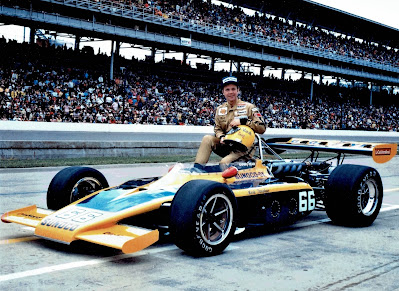Welcome to our monthlong countdown celebrating notable drivers and cars from the history of the Indianapolis 500!
 |
Majeske Photo Collection In 1973, Mark Donohue started on the front row for the third consecutive year. |
30 Days in May Bonus: No. 66, Mark Donohue 1973 Sunoco DX Eagle/Offy.
Mark Donohue changed marques in 1973 as he attempted to defend his Indianapolis
500 title. While teammates Gary Bettenhausen and Bobby Allison (doing a one-off
from his NASCAR duties) drove McLarens, which Donohue won with in 1972, Donohue
tried to unlock the secret of Dan Gurney’s Eagle.
This proved to be an exercise in frustration as Donohue
struggled to get the Eagle to respond. It had been purchased, at Donohue’s
behest, by Roger Penske (always one to cover all this bases) because of the Eagle’s
fantastic speed in the hands of Bobby Unser.
Patrick Racing also bought Eagles, with Swede Savage topping the early practice periods in May in his No. 40 STP Oil Treatment, with Gordon Johncock also showing well in the No. 20 STP Double Oil Filter. (Rookie teammate Graham McRae traded in a 1972 Lola for an Eagle and also did well in it.)
According to oldracingcars.com, Patrick and Penske each had 1972 Eagles.
Bobby Unser and Jerry Grant had 1973 Eagles for the 1973 Indianapolis 500.
For Donohue, advancements came slowly. The following are
Donohue’s words from his book “The Unfair Advantage”:
(The issue) was some kind of an aerodynamic “ground
effect,” where the nose would “lock down” at some height and stay there. But if
it was up, it could stay there, too, and begin to “fly the nose,” as they say.
To his credit, Donohue eventually figured out the Eagle well
enough to qualify at 197.412 mph, good for the outside spot of the front row –
his same starting position in 1972.
Race Day was vexing as he dropped out after 92 laps with
piston failure and finished 15th. Sadly, this was Donohue’s last appearance as
a driver at Indianapolis. He retired from IndyCar competition at the end of
1973, served as team manager for Penske in 1974, then was fatally injured in
practice for the Austrian Grand Prix in August of 1975.
As a final note to illustrate just how remarkably talented
and insightful Donohue was, it wasn’t until several years later that “ground
effect” became part of the IndyCar vocabulary. But he explained it in
1973!
#Indy500 @IMS @IMSMuseum @IndyCar @Team_Penske
No comments:
Post a Comment